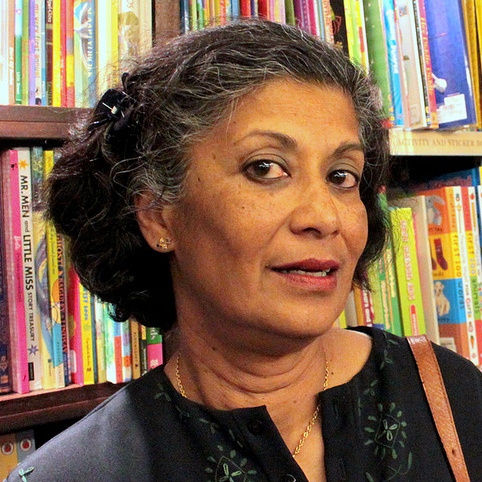A few (maybe two) people in this benighted country have asked me over the course of the years what Goan cuisine is like. This number excludes my children, who are not as ignorant of Goa as the rest of the population. My answer is simple: ‘Goan food is the best in the world.’
The confusion that this response engenders is much to my taste. Given the singularity of my position in Cape Town, where there is no person or restaurant to challenge my statement, I feel a grim satisfaction in playing on a manifest ignorance of Goa and the general lack of interest in that distant little country that, all said and done, has formed me. I have not met a single South African who has been to Goa — not on the hippie wave (though there is the writer Damon Galgut), not on a package tour, not to visit family. That, of course, is my personal experience, but apartheid was hostile to immigration from the other shore of the ocean that divides as much as it connects.
Our Mr Mandela, at his provocative best, tells the story of an encounter with ‘a five-year-old lady’ who asked him how old he was. His answer:
‘I forget.’
‘Are you very old?’
‘Yes. Very old.’
‘Why did they put you in prison?’
‘They did not like what I was doing.’
‘How long were you in prison?’
‘I forget.’
‘Was it one year?’
‘No, longer than that.’
‘Two years?’
‘No, no. Much longer.’
‘How long?’
‘I forget.’
Although Mandela was being both quizzical and playful, this exchange took place about 20 years after his release from Robben Island and, subsequently, Victor Verster prison, to which he was moved in 1988. My own absences from my homeland of Kenya have added up to almost half a century.
When pressed, I make an effort to shore up my memory of the Goan cuisine of my Kenyan childhood with a few specifics: ‘croquets’, ‘shakuti’, ‘cabbage rolls’, ‘fish curry’, ‘sorpotel’, ‘spinach boga’, ‘kebabs’. This muddle (indicative, however, of the verisimilitude that contributes to the excellence of Goan cuisine) usually acts as enough of a deterrent to further questioning. To my credit, I have never included ‘vindalho’, supposedly the most famous Goan dish but one that I did not encounter growing up in Nairobi, a long time ago. We ate well in those days; that much I know.
Meanwhile, I am forced into an ongoing dialogue with myself. Was it really so? Did I make that up? Was the butter so delicious? What is that taste, those tastes I cannot replicate? Might not even be able to locate any longer. It is a fact that I could not find sorpotel at any public restaurant or shack in Candolim in Goa and met with an uncomprehending stare when I asked for it. The Goan cuisine I struggle to remember, modified by its contact with East Africa, may not exist anymore, may have morphed, become unrecognizable …
There are some things I remember as in a dream. One of these is the custom of distributing boiled gram with chips of fresh coconut six days after the birth of a child. I was delighted to discover (in a book of folk tales by Professor Lucio Rodrigues) that this was no dream but a well authenticated custom, celebrated with different rites, the sixth day being the one on which the goddess of destiny decided the fate of the child. Goa itself, however, has been washed by a wave of forgetting. As Professor Lucio remarks, only ‘the tattered remains’ of the numerous birth and death rites of centuries past have survived.
There are still Goans in Kenya, the land of my birth. Indians were once a significant portion of the population of East Africa: nearly 30% of the population of Nairobi, the capital of Kenya, at the time of independence in 1963. Of this number, Goans were a fraction (for example, in Uganda in 1959 there were only 2,830 Goans among 69,103 Indians, according to census data quoted in Agehananda Bharati’s The Asians in East Africa). However, Goans made up in self importance for their smallness in numbers, reluctant for the most part to recognise themselves as Indians and ready to part with a vital aspect of their identity by adopting English as their mother tongue. In these circumstances, food was an important identifier.
In the context of my over confident description of Goan food to unknowing South Africans, I am embarrassed to explain sorpotel, which is a mixture of belly pork and liver, both of which are readily available in South African supermarkets. For me, sorpotel is like the Goan national flag. When I returned home to South Africa from Goa several years ago, I brought back a large jar of sorpotel masala, obtained privately, wrapped in layer upon layer of plastic, resting hazardously amid the clothes in my suitcase. I did not, could not, share the end results with my friends. I suspected an in-built resistance to fat pork and liver and I could not risk wasting my precious hoard.
And did it taste like the sorpotel of my youth? I don’t know.
And why, I ask myself, this lingering appetite for sorpotel, a dish that may not even be originally Goan, derived not from the Konkani ‘soro’ (meaning alcohol or liquor) but from the Brazilian ‘sarpatel’ which was created by slaves from thrown away meat parts such as feet and ears and tails? Or, possibly, originating in Portugal itself and transferred from there to Brazil and to Goa. Who knows?
The aftermath of independence in Kenya in the sixties saw the dissolution of my extended family. With the imminent departure of one of my cousins for the United States, it was decided to hold a family gathering at which as many of us as possible could meet, for the last time. We were at least 50 persons, including little ones, the children of cousins, and older ones who were also cousins, my father’s family network encompassing the children of the children of his oldest sister, who were of similar ages to those of my brothers and myself and other cousins.
My father was born in Nairobi, then a frontier town, in the first decade of the 20th century, one of eight children, the last born after the birth of my oldest aunt’s first child. We were, thus, a complex family, ranging widely in age and relationship, meeting at birthday parties and participating, particularly during the Christmas season, in an exchange of visits.
I was on the brink of departure for university in the UK at the time of that last family gathering. Over the course of a few years, some of us left for Canada, others for the UK, a minority for Goa. On the occasion of our last gathering, we posed for a formal photograph in front of St Teresa’s, the school in Eastleigh (risen now from its slum status) where I completed my primary and secondary schooling. Two of my aunts were teachers in the secondary school, my cousin’s wife served in the primary school, a cousin’s wife was the bursar, a cousin’s husband the science master! The school itself was run by two Irish nuns, one of whom was named Mother Teresa Gertrude, the only nun for whom I retain any real liking.
Sorpotel, no doubt, featured on the menu of that last gathering. It was the food of celebrations, of birthdays and Christmas, appearing on the table with mounds of yellow rice topped with burnt shredded onions and toasted slivered almonds, salads, stuffed eggs, ‘tendlis’ cut lengthwise to reveal their orange hearts, maybe even the curried tripe we called ‘booch’, and chicken curry and fish.
Surely there was fish. Kingfish or tilapia from Lake Victoria.
Of my father’s siblings none remain. The graves of some of them, and of some of their children, can be found amid the tangle of weeds and grass and flowers in the cemetery in Nairobi’s Forest Road (re-named after one of my heroines, Wangari Maathai), not far from the small stone house in which we once lived, now a derelict, barred and boarded structure. My father, at his own wish, was buried in his father’s grave. The intrepid freedom fighter Pio Pinto is buried in the same cemetery. The graves are, for the most part, untended. People are afraid to go into the cemetery because of the very real danger of attack, not least by gangs of feral children.
‘So why did you come to South Africa?’ the five-year-old lady might ask of me.
‘They gave us money to do research. To find knowledge.’
‘And did you find it?’
‘No. I only found out later about many things. Many bad things.’
‘And were there bad things before?’
‘Yes, and good things too.’
‘How long have you been here?’
‘Very long.’
‘One year?’
‘No, no, longer than that.’
‘Two years?’
‘No, no, much longer.’
‘How much longer?’
‘I forget.’
Ending his story, Tata Madiba added the last line, and it seems it was the five-year-old lady who had the last word –‘You are a very stupid old man.’
And so it goes, and has gone.










